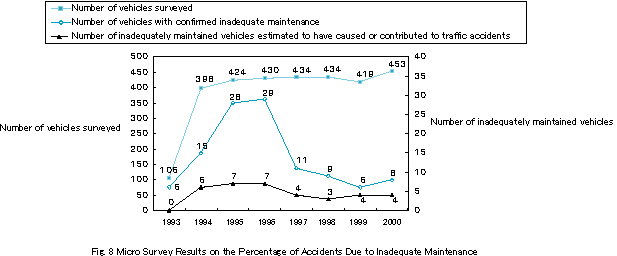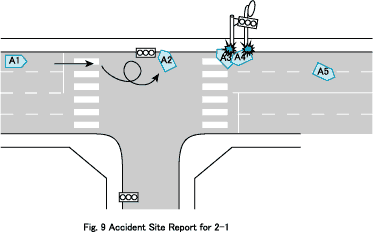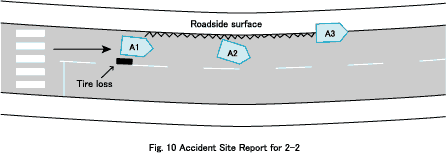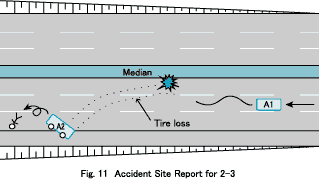 |
||||
|
|||||||
 1. Micro Survey Results on Accidents Due to Inadequate Maintenance (1993 - 2000) |
|
Since micro surveys were initiated in 1993, 3,098 vehicles have been investigated, and of these, 112, or 3.6% of the total, were
confirmed to have been inadequately maintained. It was also estimated that 35 vehicles, or 1.1% of the total, had caused or contributed to accidents. Figure 8 reveals that the number of vehicles found to be inadequately maintained peaked at 29 in 1996, decreased thereafter, and then increased again in the year 2000. There continues to be little to no change in the number of vehicles that are estimated to have caused or contributed to accidents. |
|||
 |
|||
| 2. Primary examples of how inadequate maintenance may cause or contribute to traffic accidents | |||
| 2-1 Single-Vehicle Accident Caused by Wheel Slippage of Vehicle That is Overdue for Inspection | |||
 |
|||
| (Accident Summary) During heavy rain, ordinary passenger vehicle A, which was being driven by a 20-year-old male, down a two-lane road with a median went into a spin and collided with a traffic signal and roadside lamppost (Fig. 9) |
|||
| (Damage Degree) Minor injury to driver, major damage to vehicle |
|||
|
|||
| (Accident Cause) Since there had been much precipitation, and the tread on both rear tires of FR car was worn down (Photo 2), and the vehicle had spun halfway around (or 1.5, 2.5 revolutions) before colliding with the signal post, the accident was most likely due to hydroplaning (Note). The vehicle in question was two years overdue for mandatory inspection, and as such, was being driven without having undergone maintenance inspection, so the two rear tires had been allowed to wear down to dangerous levels. |
|||
| (Accident Prevention Measures) Driving a car that has not undergone mandatory inspection is a legal violation. It is important to remember that vehicle maintenance is the responsibility of the vehicle user. To help prevent accidents of this kind, be aware of the expiration date written on the inspection certificate and on the back of the inspection sticker that is affixed to the windshield. (Note) Hydroplaning occurs when tire tread has worn down to where it cannot channel water away from the car so the car slides across the surface of the water. |
|||
| UP | |||
| 2-2 Accident Due to Wheel Loss of Damaged Magnesium Wheel | |||
 |
|||
| (Accident Summary) Passenger vehicle A, driven by a 20-year-old male, accelerated to pass the vehicle in front of him, which had pulled over to the side of the road, and promptly lost its rear right tire. Dragging its rear right axle, the vehicle proceeded another 500 meters before coming to a stop .(Fig. 10) |
|||
| (Damage Degree) No injury to the driver, serious damage to vehicle. |
|||
 Photo 3 Lost rear right tire |
|||
| The driver testified that, prior to the accident, some strange sounds had been coming from the rear of the car (most likely from the rear wheels). Post-accident investigation confirmed that the rear left wheel had also suffered damage. |
|||
| (Accident Cause) Photo 3, of the area where the wheel fell off, reveals major deficiencies in the magnesium wheel, which developed a crack and then ruptured immediately prior to the accident. |
|||
| (Accident Prevention Measures) -If wheel abnormalities (strange sounds, etc.) are noticed while driving, the driver must make sure to choose a safe place, stop the vehicle immediately, and inspect it for damage. Before changing to light alloy wheels, the driver should check to see that they have the JWL safety mark (See Note). (Note) The JWL safety mark verifies that the wheel conforms to safety standards. |
|||
| UP | |||
| 2-3 Rollover Accident Due to High-Speed Driving and Tire Rupture | |||
 |
|||
| (Accident Summary) Small-sized van A, driven by a male in his fifties, proceeded at approximately 100 km/h along the middle lane of a three-lane (one way) expressway, experienced a tire rupture, began to weave and crashed into the median, where it rolled over. The driver, who had not been wearing a seat belt, died after being ejected from the car.(Fig. 11) |
|||
| (Damage Degree) Death of driver, serious damage to vehicle. |
|||
 Photo 4 Small-sized van A that rolled over |
|||
| (Accident Cause) It was confirmed that since the tire tread interior was discolored, it is most likely that when the vehicle was repeatedly driven at high speeds and with insufficient tire pressure, the tires became abnormally hot and finally ruptured. Since a discrepancy was discovered in measuring the tire pressure of the vehicle's front tires, it can be assumed that because the pressure in the front right tire was low, the pressure in the rear right tire was also low. |
|||
 Photo 5 Right rear tire that ruptured |
|||
| (Accident Prevention Measures) - Always make sure to carry out (tire and other) inspections on a daily basis, before traveling at high speeds. In particular, make sure to adjust tire pressure to the manufacturer's recommended standards. - It is important to remember that vehicle safety and maintenance is the responsibility of the vehicle user. |
|||
| UP |
Institute for Traffic Accident Research and Data Analysis (ITARDA) |